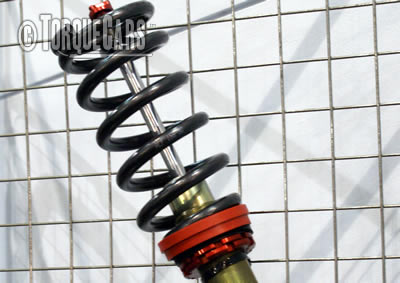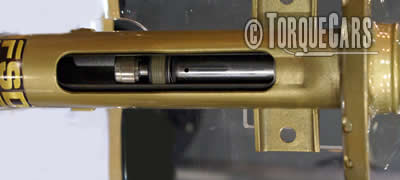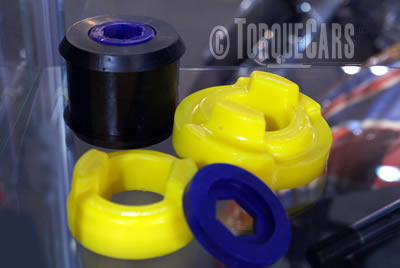Fine tuning your suspension setup for your driving style.
"Things are bound toe improve!"

Many people just concentrate on lowering the car and assume that stiffer springs and the lower ride height will improve handling.
However there are many other settings for your suspension which can make a massive difference to the handling before you even think about changing components.
The shocks are generally a piston inside a liquid and some have an additional gas chamber to absorb shocks (gas compresses whereas liquid does not compress under pressure.)
Shocks can have a fairly complicated structure.
Testing the shocks on your car you bounce the car – if you get more than one bounce then your shock are on the way out.
Without shocks the car would drive like a thing on a spring and just bounce everywhere.
(Damper – the shock absorber).
Bound & Rebound settings
This is the dampening force of the shock absorber. Bound is the rate at which the shock allows compression and rebound is the rate at which the shock releases the compression.
If your suspension has a dampening control then you can play with these settings and get the optimum setting. Electronic in car adjustments is now possible and if you are considering drifting your car you really should invest in one of these set-ups.

Camber
This is the angle of the wheel to the road. If you put all of your weight on the outside of your feet you would have a positive camber and if you rolled your feet inwards so all your weight is on the inside you get negative camber.
As the car rolls into a corner the camber can make a big difference to handling and also tyre life. Sadly the best camber setting for handling will cause premature wear to the tyres!
Front wheels are set up to get negative camber as the wheel is deflected up. The camber setting is the angle of the wheel to the road as well as the angle of the wheel to the chassis. As the car corners and rolls the suspension geometry must maintain the best angle of contact of the tyre to the road.
This is why manufacturers go to such great lengths to set up their cars correctly and when you make suspension modifications it should be your aim to keep as close to the makers spec as possible. Generally the more tuned the suspension set-up the less variation there is under stress and the less room you have to play with. Start off with the manufacturers settings and alter these slightly increasing the negative camber and test the results. If you can’t feel any difference then why are you bothering!
Remember that kerbing wheels and hitting bumps can knock out the camber setting. Tyre temperature alters the camber so the camber is best set with warm tyres!
Caster
Imagine it is a windy day and you lean forwards – your legs now have a negative caster. The angle of the wheel hub in relation to the suspension arm is described as the angle of caster. The positive caster keeps the wheel straight when going along – a bit like a pram wheel the connecting arm to the hub is set slightly back. Stability results whereas a neutral camber would result in the wheel wobbling around the axis. The angle a car wheel is set at generates more camber when the wheel is turned.
Toe
Stand like Charlie chaplain with your heels together and your toes out. Now imagine your cars tyres are at this angle too – this is known as Toe Out. Toes in is where your heels are apart and the toes are together. Obviously the angle of Toe in a car is barely perceptible.
The effect of this setting on the car is stability – toe in gives great stability on the straight and the car resists a turn to the right or left. Toes out gives a much quicker steering response. Toe in is a road car setting and Toe out is a track setting – it is up to you to decide how much Toe you want. Toes applies equally to the rear tyres although they are generally set as a lower angle than the fronts.
Roll
Eliminating roll in corners helps cornering stability and keeps all four wheels on the ground. When pushed really hard most production cars will lift a rear wheel of the ground and when cornering you really need as much rubber in contact with the black stuff as possible.
The roll bar also known as a sway bar helps to keep the car level in a corner by taking the lift from one side and trying to move it to the other. As this is not possible the lift is effectively pulled down and everything is kept in contact with the road.
Strut braces stiffen the top of the suspension mountings and help reduce flex when you are pushing the car hard so also have a minor benefit at reducing roll.

Spring stiffness
If the springs are too stiff the car will bounce over humps and lumps in the road.
If it is too soft the car will just wallow along (it’ll be a really comfortable ride though).
The best shocks are adjustable on the car and let you get the set up perfect to match your driving style.
If you have slightly softer springs on the front the nose of the car will grip in corners and you will have more oversteer (back gets lighter and tends to go wide in corners). If the soft springs are on the back you will get understeer, which is how most production cars are set up nowadays because the inexperienced driver reacts better to understeer than oversteer.

Bushes (bushings)
These connect the suspension components to the chassis of the car. The rubber ones deteriorate in time.
New polyurethane bushes last longer and keep the handling much tighter but because they are harder they can make the ride a little more bumpy.
A set of new poly bushes will sharpen up the handling of your car reducing the slop and sway associated with rubber ones.
You can get a full set of suspension bushes for most cars although rarer models often only have the main bushes available in polyurethane. Custom bushes can often be made up to suit your application.
Please join us in our friendly forum to catch up with the latest trends in tuning and car modification for your car.
If you liked this page please share it with your friends, drop a link to it in your favourite forum or use the bookmarking options to save it to your social media profile.
Check out TorqueCars new YouTube channel, and see their awesome new content...
Feedback
Please use our forums if you wish to ask a tuning question, and please note we do not sell parts or services, we are just an online magazine.
Help us improve, leave a suggestion or tip
